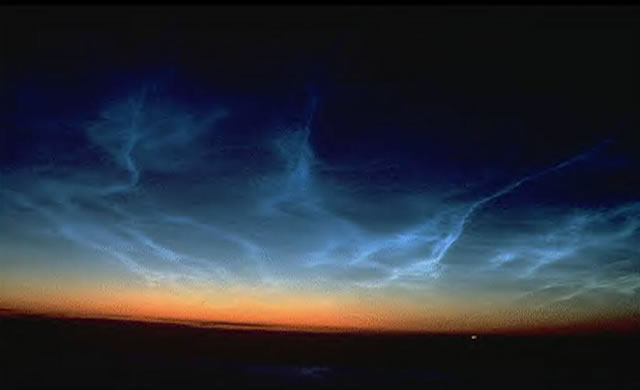
Credit: NASA
Ogni estate, qualcosa di strano e meraviglioso accade in alto, sopra il polo nord. Cristalli di ghiaccio cominciano ad aggrapparsi ai resti fumosi di meteore, formando nubi blu elettrico con viticci che si increspano ipnoticamente nel cielo al tramonto.
Le nubi nottilucenti, note con la sigla “NLC”, sono una delizia per gli osservatori del cielo, alle alte latitudini, e intorno al Circolo Polare Artico la loro stagione di visibilità è sempre attesa con impazienza. La notizia è che quest’anno le nubi nottilucenti hanno un esordio precoce. Il veicolo spaziale della NASA AIM, che orbita attorno alla Terra in missione per studiare le nubi nottilucenti, ha iniziato a registrarne la presenza già il 13 maggio scorso. “La stagione 2013 è notevole perché è iniziato nell’emisfero settentrionale una settimana prima di ogni altra stagione, rispetto alle precedenti osservazioni della sonda spaziale,” riporta Cora Randall del Laboratorio per dell’Atmosfera e Fisica dello Spazio presso l’Università del Colorado. “Questo è molto probabilmente prima di quanto mai prima d’ora.” L’inizio precoce è extra-sconcertante a causa del ciclo solare. I ricercatori sanno da tempo che le NLC tendono ad avere un picco durante il minimo solare ed apparire molto meno durante il massimo solare, e questo evento rivela sufficientemente una forte anti-correlazione. “Se non altro, ci saremmo aspettati un inizio ritardato quest’anno, proprio perché il ciclo solare è vicino al suo massimo”, dice Randall. “Questo per quanto riguarda le aspettative.” Per gli osservatori del cielo, questo significa che è il momento di prestare attenzione al cielo al tramonto, dove le incantevoli nubi blu elettrico sono spesso più osservate. Un inizio precoce potrebbe preludere nubi più luminose e più ampia visibilità rispetto al passato.
Every summer, something strange and wonderful happens high above the north pole. Ice crystals begin to cling to the smoky remains of meteors, forming electric-blue clouds with tendrils that ripple hypnotically against the sunset sky.
Noctilucent clouds—a.k.a. “NLCs”–are a delight for high-latitude sky watchers, and around the Arctic Circle their season of visibility is always eagerly anticipated. News flash: This year, NLCs are getting an early start. NASA’s AIM spacecraft, which is orbiting Earth on a mission to study noctilucent clouds, started seeing them on May 13th. “The 2013 season is remarkable because it started in the northern hemisphere a week earlier than any other season that AIM has observed,” reports Cora Randall of the Laboratory for Atmospheric and Space Physics at the University of Colorado. “This is quite possibly earlier than ever before.” The early start is extra-puzzling because of the solar cycle. Researchers have long known that NLCs tend to peak during solar minimum and bottom-out during solar maximum—a fairly strong anti-correlation. “If anything, we would have expected a later start this year because the solar cycle is near its maximum,” Randall says. “So much for expectations.” For sky watchers, this means it’s time to pay attention to the sunset sky, where NLCs are most often seen. An early start could herald brighter clouds and wider visibility than ever before.
Source/Continue reading → NASA.gov

















